Etiquette FLAG GUIDE



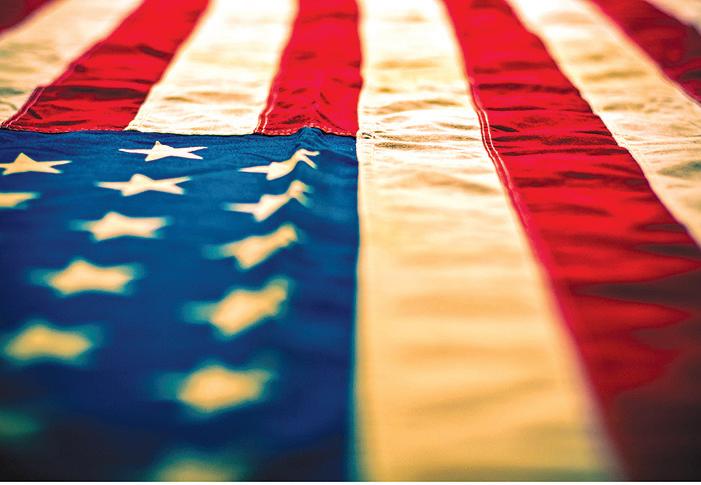
Many of our nation’s best-known American flags have memorable American stories behind them — and such is the case for the tale of Captain William Driver, a stirring account of patriotism and courage.
A sea captain who sailed the world’s oceans, Driver is best known for having given the name “Old Glory” to the American flag. The story of his flag’s journey from the deck of Driver’s ship to the halls of the Smithsonian Institution is a testament to the enduring power of the American spirit.
Driver was born on March 17, 1803 in Salem Massachusetts, joining the merchant marines when he was 14. In 1831, he was given a 17” by 10” American flag with its then-24 stars by his mother. She and other Salem seamstresses had made it for him to display on his ship, the Charles Doggett.
Union.
The Smithsonian reports, “During the Civil War, no flag became a more popular symbol of Union loyalty than the worn and imperiled standard belonging to 19th-century sea captain William Driver, who was originally from Salem, Massachusetts. His defiant flying of it — from his Nashville, Tennessee household during the midst of the conflict—made national news.”
However, after the war began, he took pains to hide it, sewing it inside a quilt and hiding it under his mattress. Several times Confederate supporters and officials searched his house looking for the flag, but they never found it.
We remember the men and women who have honorably served this country throughout history. We remember their courage, their selflessness and their dedication. We remember the hardship, the suffering and the sacrifice they endured. On Memorial Day and every day, we remember with respect those who have have fought to defend our democratic ideals and secure our freedoms. With deep gratitude, we salute our country’s brave and honorable veterans.
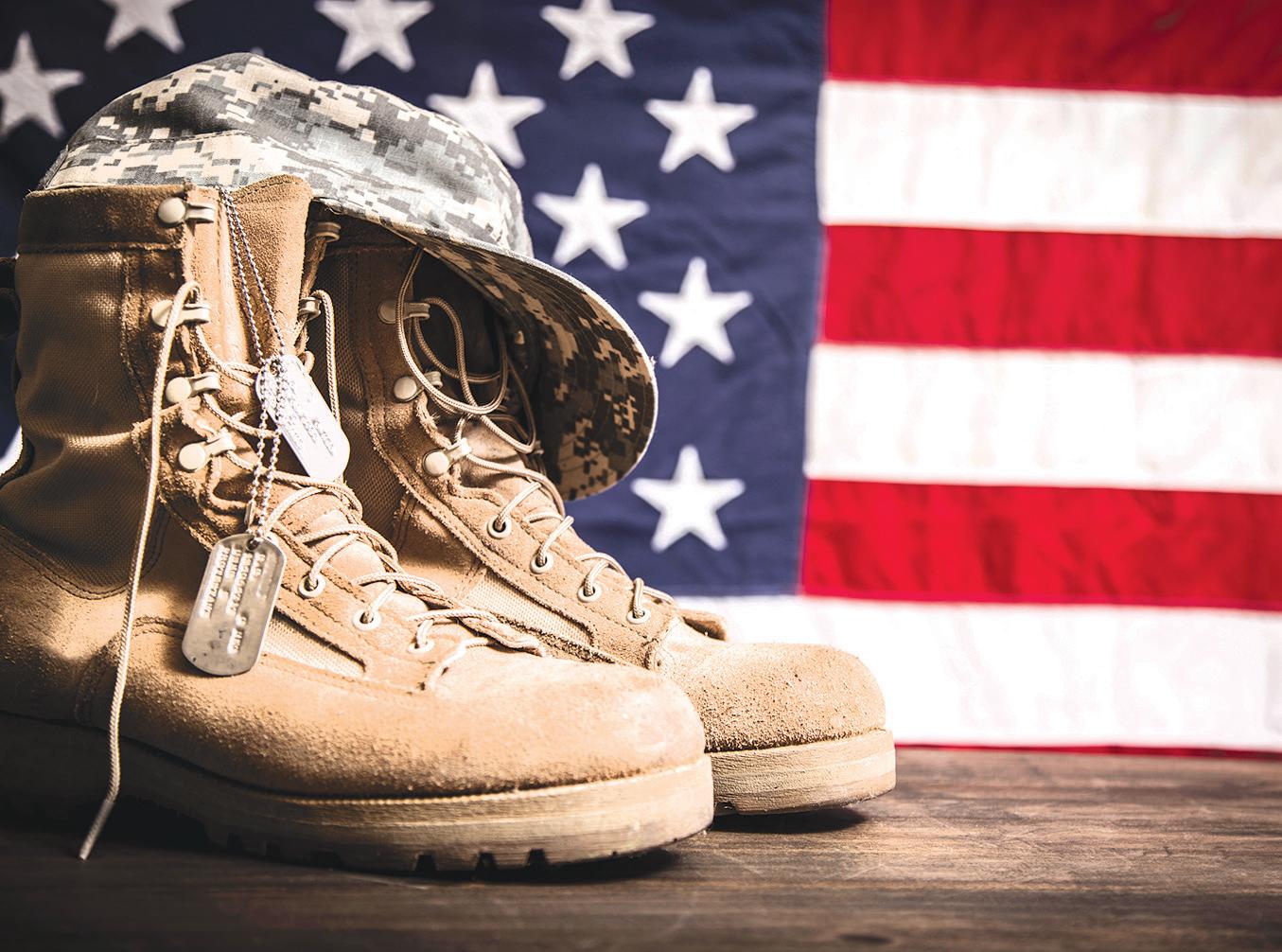

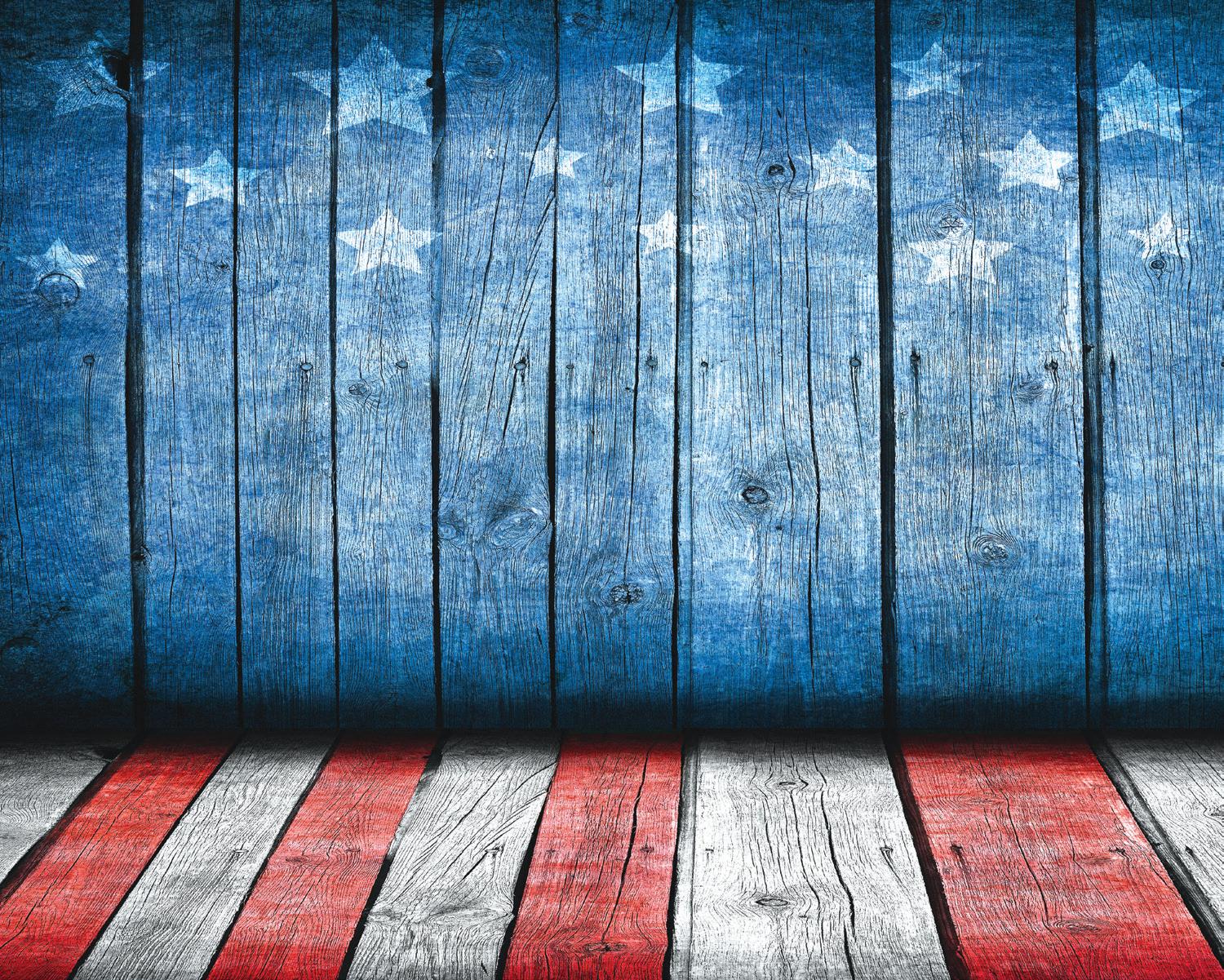
He referred to the flag as “Old Glory,” the first person to give it that name. He carried it with him throughout his career as a sea captain.
In 1837, he retired and moved to Nashville, Tennessee, where he proudly displayed the flag outside his residence. At one point, he, his wife and daughters sewed on an additional ten stars and he added a small white anchor to the lower right corner.
In the early 1860s, tension began to arise between the North and the South and Tennessee seceded from the


Then the 6th Ohio Infantry captured Nashville for the Union Army. On the date of the victory, Feb. 22, 1862, Driver asked the Regiment’s captain if his Old Glory could be displayed over the Capitol building. The Captain agreed and Driver stood guard over it all day and night until his flag was replaced with a new one the following day.
Driver served as the provost of Nashville for the remainder of the Civil War.


When he died in 1886, Congress designated that his grave could display the American flag at all times, one of the few places where it is allowed to be flown 24 hours a day.
In 1922, his daughter, Mary Jane Roland, gave the original Old Glory flag to President Warren G. Harding who then donated it to the Smithsonian, where it is on display to this day.

Compiled by the U.S. House of Representatives’ Office of the Law Revision Counsel, these guidelines ensure that you display the flag in the most respectful manner.
DO place the U.S. flag to the right when displayed with any other flag. If part of a group of local or organizational flags, the American flag should be placed in the center and/or highest point. International flags should be flown at the same height.
DON’T use the flag to cover cushions, as part of a costume, or for advertising purposes. Military personnel, police officers, firemen and patriotic organizations may use a flag patch.


DO follow presidential or governor’s orders to fly the flag at half staff. These orders are made after national tragedy or the death of an important person. The flag should be hoisted to its peak before being lowered to half staff. Before it is lowered for the day, the flag should again be raised briefly to its peak.
DON’T attach anything to a flag. The flag also shouldn’t be used as a recepta-

cle of any kind.
DO place the flag to a speaker’s right as they face the audience in an indoor meeting or other gathering.
DON’T display a flag with the blue area to the right when looking in from any window. The flag should be on display for those who are outside.
DO position a flag over the middle of a street with the blue field of stars pointing to the north on streets going east and west. On streets going north and south, the blue area should be to the east.
DON’T place the blue area over the right shoulder of the deceased when used to cover a casket. The flag should also never be lowered into a grave, or be in contact with the ground.
DO hoist the flag out with the blue area first when suspending it on a rope over a sidewalk.
DON’T carry the flag to the left when marching in a procession with other flags. The U.S. flag should be held to the right if being carried by itself. If among a line of other flags, the Star-Spangled Banner should be carried front and center.
Is your flag dirty or showing a small amount of wear and tear? That doesn’t mean it has to be retired.
In fact, the Flag Code encourages us to mend or clean banners when necessary. Here’s how.
Allowing your flag to touch the ground is a sign of disrespect, and it might also leave behind a nasty smudge. If that happens to you, address the situation immediately so you don’t end up with a lasting mark on the banner. Always use cold water and a mild detergent, and wash it by hand. Once you’ve scrubbed away the grime, lay your flag flat to dry rather than hanging it up, since the material may stretch out of shape. You’ll also lower the chances of any colors bleeding into one another.
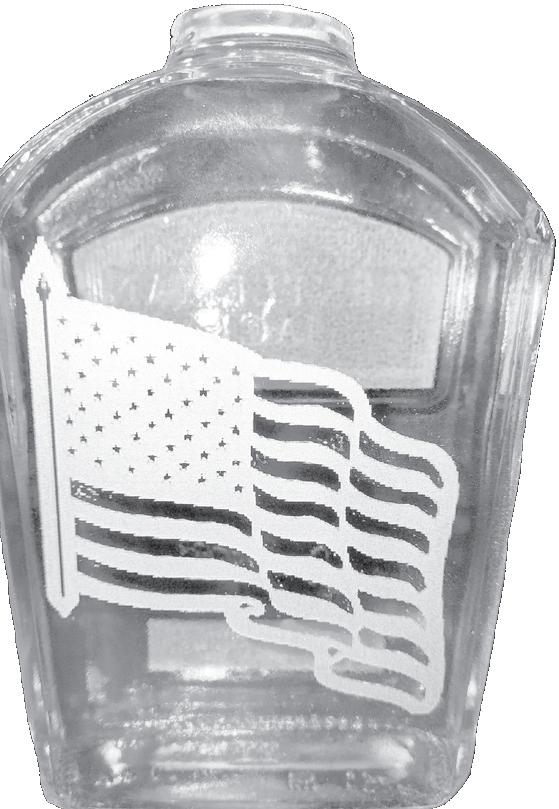
Dirt, air pollutants, salt and debris


aren’t the only worries. Take regular opportunities to closely inspect the banner for any holes or fraying caused by the flag’s constant exposure to wind. If you employ an all-weather flag, it’s particularly important to do these evaluations after big storms. Even very small imperfections can rapidly expand into major holes in bad weather conditions. At the same time, frequent modifications can change the flag’s shape and appearance — so always proceed with great caution.
Unfortunately, none of this will keep your flag flying forever — in particular if you display it rain or shine. Government estimates have placed the expected lifespan for the average cotton or nylon flag at about 90 days, based on daily display from dawn to dusk with no inclement weather. Flags flown 24 hours a day might last one fourth as long before they begin to fade and fray.

The American flag is a symbol of the country’s history, pride and success in overcoming political oppression. Through its many incarnations and variations, the Stars and Stripes has waved over government buildings, schools and private residences.
According to History.com, in 1775, the Second Continental Army led to the creation of the first “American” flag. However, that flag was too similar to the British Union Jack flag, George Washington requested a revision. In 1777, the Second Continental Congress passed a resolution stating that the “flag of the United States be 13 stripes, alternate red and white.” Furthermore, the “union” was represented by 13 stars of white in a blue field, “representing a new constellation.”

More than a century later, a small-town Wisconsin teacher named Bernard Cigrand came up with the idea for an annual flag day in 1885. Even though the Fourth of July, a holiday in which the flag is prominently and proudly displayed, had long been celebrated as the

birthday of the United States, Cigrand wanted a holiday that would focus specifically on the flag in all its glory. June 14 was selected because it marked the anniversary of the official adoption of the first flag. Cigrand led his school in the first formal observance of the holiday, and throughout his life continued to advocate for respect of the flag.
Various other organizations liked the idea of a day to honor the flag, including the State Board of Education of New York, the Betsy Ross House and the New York Society of the Sons of the Revolution. Yet, it wasn’t until May 30, 1916, that Flag Day was officially established by presidential proclamation by President Woodrow Wilson. Still, it would take another 33 years for President Truman to sign an Act of Congress designating June 14 as the official National Flag Day, which he did on August 3, 1949.
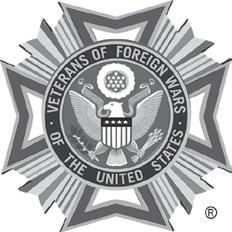
Americans can honor the flag by displaying it on Flag Day. Here’s how to display the flag properly, courtesy of Military.com.
• The flag should be free of any
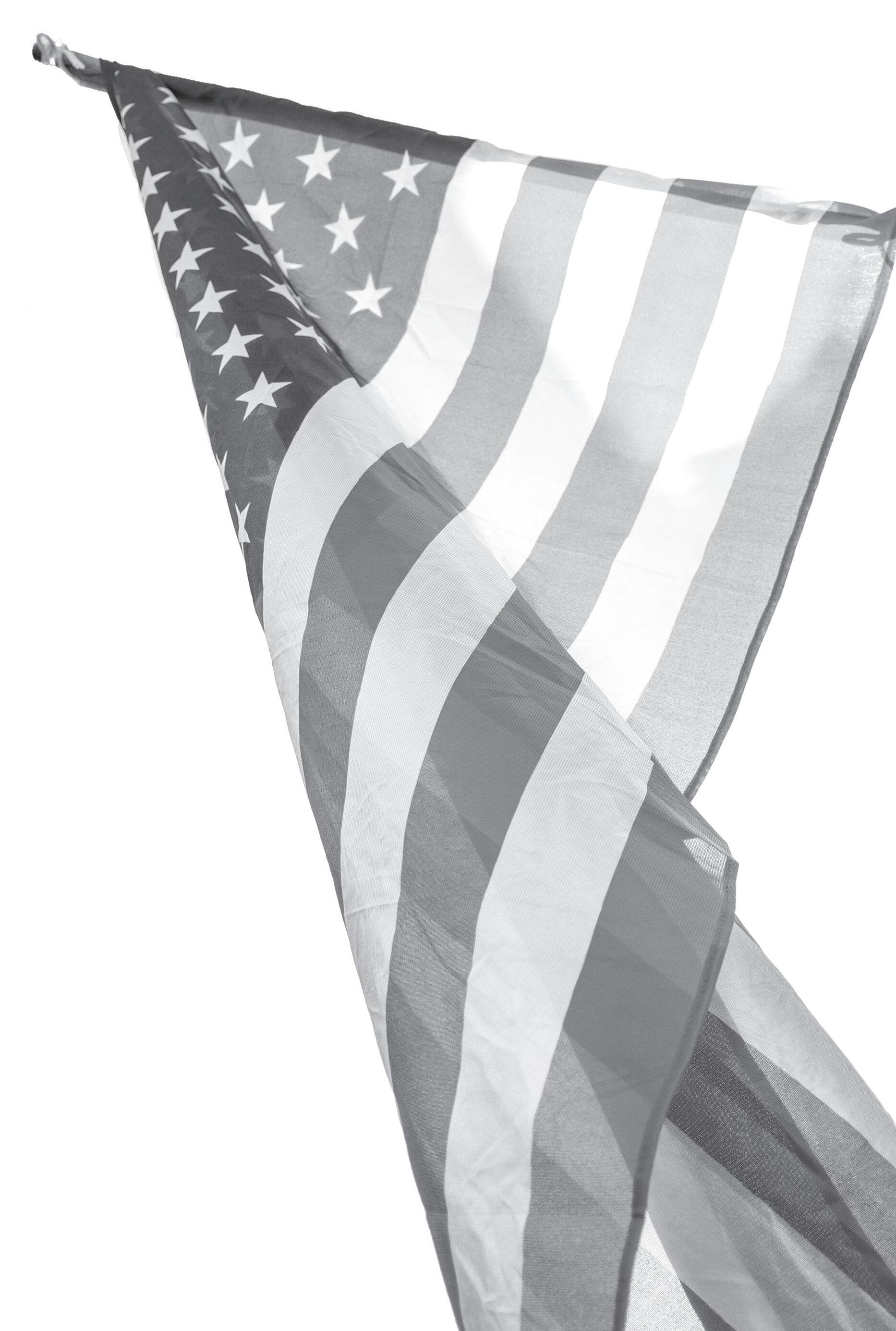
If the story is to be believed — and evidence suggests it is more myth than fact — the current design of the U.S. flag was one student’s effort to get a better grade.
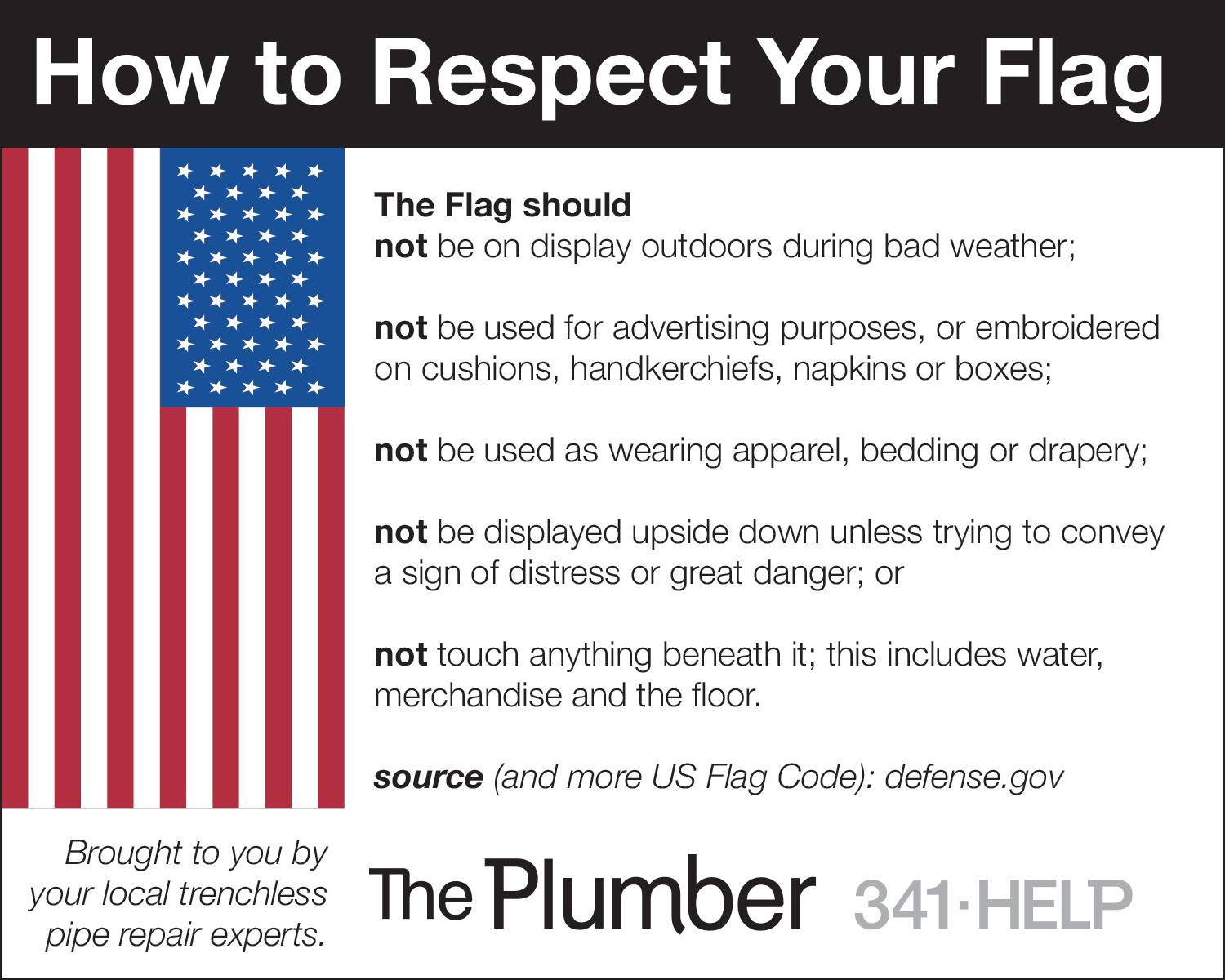
Robert Heft was born in 1941 in Saginaw, Michigan, and usually gets the credit for designing the 50-star flag. It’s a story that, like the one of Betsy Ross designing the original flag, doesn’t have a lot of proof supporting it. However, it’s a popular one that went mostly unchallenged until 2022 when a Slate reporter started investigating.
The story claims he was a 17-yearold high school junior working on a history project. He made a new U.S. flag with 50 stars using his grandparents’ flag, mending fabric and an iron. His teacher, Stanley Pratt, gave him a B-.
His teacher is quoted, “I gave him a grade that he didn’t like much, so I told him to get the thing approved in Washington and maybe I’d change the grade.”
Heft sent the flag to Ohio’s governor, Michael DiSalle, who displayed it at the state Capitol and the governor’s mansion. He then gave it to his
congressman, Walter Moeller. That seemed to be the end of it and the next year he graduated from high school and started working for Diamond Power Specialty.
Then one morning at work he got an unusual call — it was President Dwight D. Eisenhower. He was calling to tell Heft that his flag had won a contest over thousands of other designs and was going to officially be designated the new 50-star flag. Eisenhower invited Heft to a ceremony at the White House.
Heft reported later that he put the president on hold to ask for the time off. Once it was granted, he came back to the phone and said, “Dwight, are you still there?”
On Independence Day, 1960, Heft sat between his congressman and the president watching the flag he designed be raised for the first time. He claims that throughout the ceremony, the only thing he could think about was asking his history teacher to change his grade.
He claims he left Washington, drove home and the next day we nt to the school and reminded Pratt what he had said back when Heft was still a junior. Pratt then changed the grade from a B- to an A.
“I guess if it’s good enough for
The story became part of the American mythos surrounding the flag. When Heft died in 2009, his grave -
stone was flag-shaped and lists him as “Designer of America’s 50-Star Flag.”

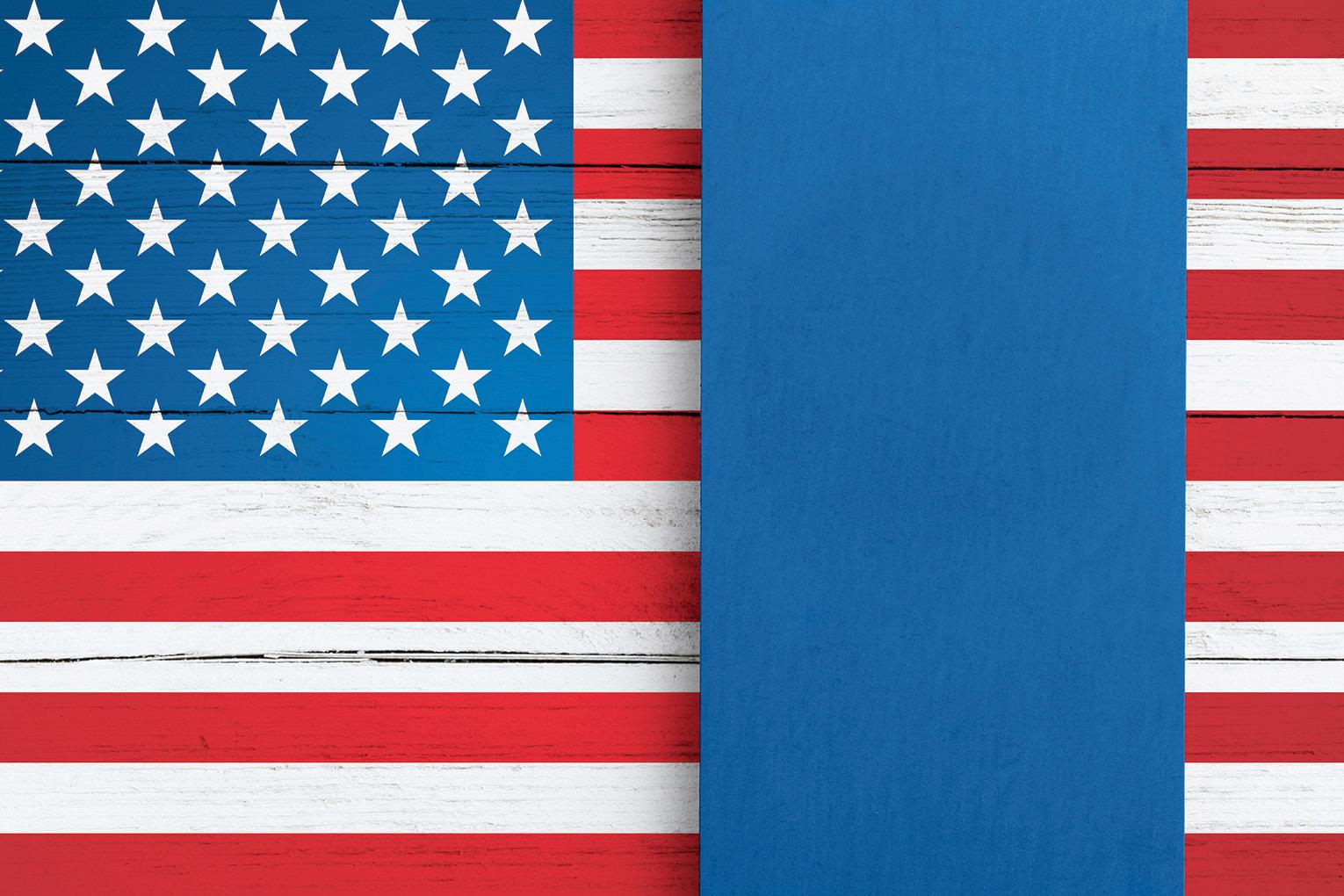
However, as the reporter from Slate discovered, there were many holes in his story and very little proof that it was accurate. Rather it has become one of those patriotic tall tales that grow with time because it makes people feel good about the flag and the country.

Washington, it’s good enough for me,” is what he is reported as having said.
To all who have put their lives on the line in defense of the flag.
Some museums are home to famous flags. The Smithsonian presents and protects the original Star Spangled Banner that inspired Francis Scott Key to write the “Star Spangled Banner.” The flag was made by Mary Pickersgill, her daughter, two nieces and an indentured African American teenage girl.
While historians today insist that the Betsy Ross story is more myth than fact, it is part of popular legend. While she may not have made the first American flag, she did make several for the Pennsylvania navy. A replica of what is considered the original Betsy Ross flag is on display in the Betsy Ross House, 239 Arch Street, Philadelphia.
The building is a popular place for educational programs and tourism and serves as the headquarters for Philadelphia’s Flag Day celebrations.

Located on Constitutional Avenue in Washington D.C., the National Museum of American History is home to one of America’s most iconic flags, Old Glory. It is a large flag that belonged to Captain William Driver. It sailed with him
planted at the top of Mt. Suribachi. He arrived just as another group of Marines was planting a larger flag. The photo became a icon and the photographer won a Pulitzer Prize. Both of the Iwo Jima flags are now on display at this free museum.
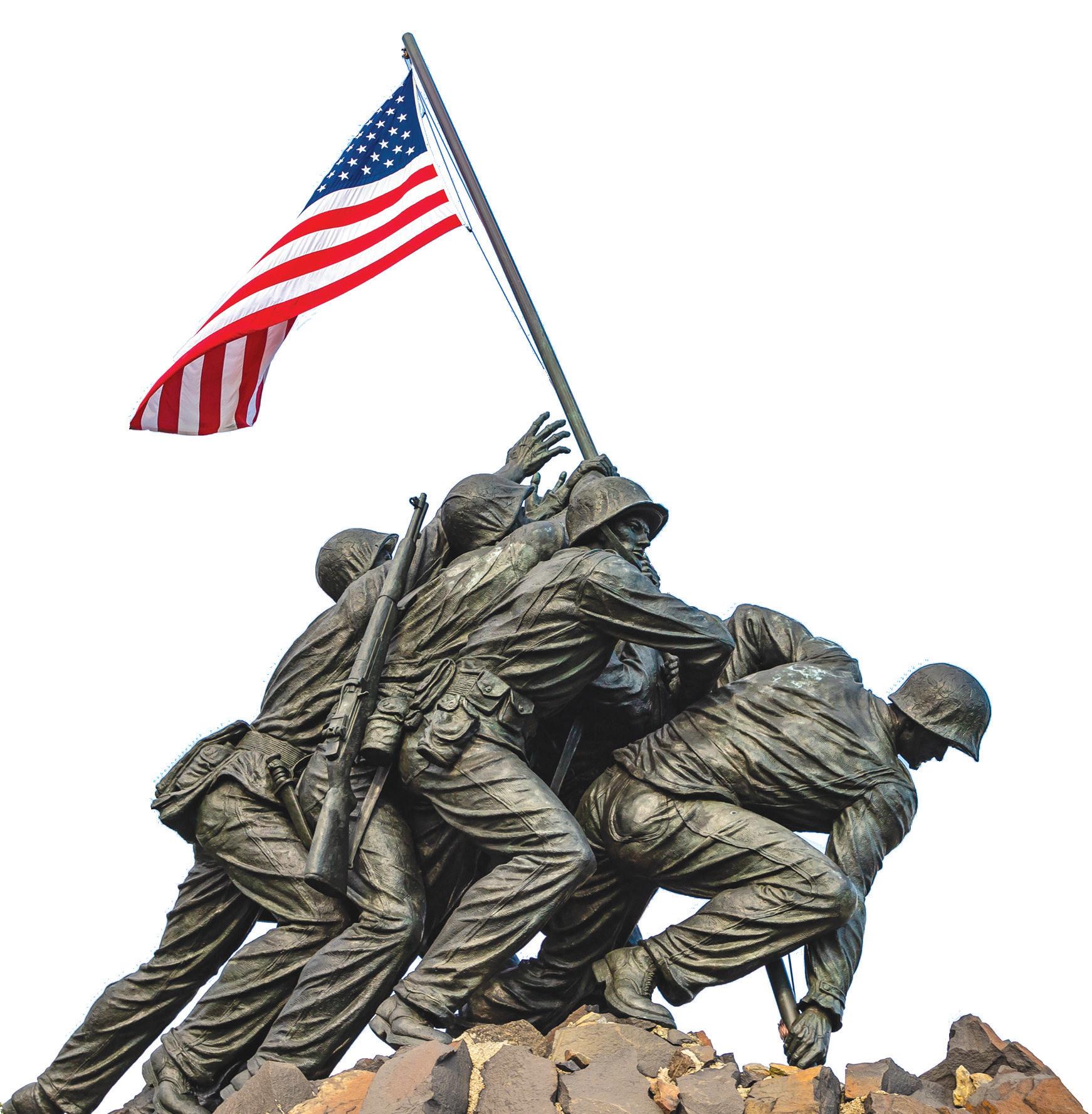
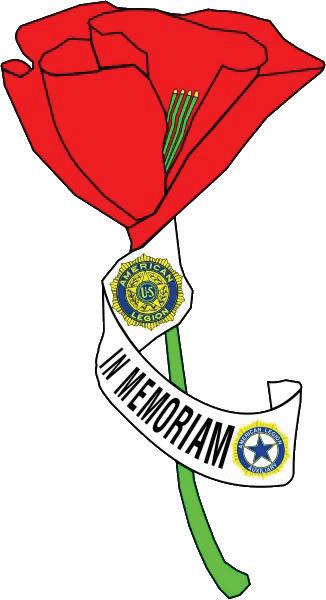
Six U.S. flags have been planted on the moon. For those who want to see a replica of them, they can visit the National Air & Space Museum on Independence Avenue in Washington D.C. The originals were ordered from a government supply catalog and are about three feet by five feet.
One of the newer additions to famous American flags is the one that firefighters raised on Ground Zero of the World Trade Towers after 9/11. A photojournalist captured the event, but a few hours later, the flag went missing. It wasn’t discovered for another 15 years, but it is now on display at the Sept. 11 Memorial & Museum, 180 Greenwich St. New York, NY.

The Spearfish Post 164 American Legion Family
Memorial DayNever Forget Their Service
thanks and honors those who courageously gave their lives in combat and also those who bravely fight today.
With so many rich histories and stories surrounding the flag, it’s not surprising that there are museums all around the country that draw people deeper into flag heritage.
The U.S. flag is now one of the most popular subjects of U.S. stamps, but it took awhile for it to catch on.

On July 4, 1960, the U.S. Post Office released the first stamp showing the U.S. flag as we know it today—13 stripes and 50 stars. It celebrated Hawaii joining the U.S. as its 50th state.
It marked the first time that the flag was the central part of the design of the flag and not just an accent or part of a story and the first time that it was reproduced in its actual colors. Surprisingly, the stamp was controversial at the time. Many claimed it was disrespectful because the stamp would eventually be canceled and that selling it as postage violated the flag code’s ban on using the image for commercial purposes.
Those objections would soon fade and now stamps celebrate the flag and help people learn more about its history and the culture surrounding it.
Many stamps help tell the story of flags.
In 1952, the postal service issued a stamp marking the 200th anniversary
of Betsy Ross’ birth. The three-cent stamp showed the seamstress pre senting a flag to George Washington. Shortly after it was released, letters flooded in from historians pointing out that the story of Betsy Ross was most likely a myth and that there wasn’t historical evidence for it. In 1948, the postal service honored the composer of “The Star Spangled Banner,” Francis Scott Key, with a three cent stamp. To either side of him are the flags from 1814 (the year he composed the anthem) and 1948. In 1952, a stamp was issued honoring Marquis de Lafayette and his arrival in America in 1777. The stamp features both the U.S. and French flag.
One of the oldest appearances of the flag on a stamp was in 1869. In what collectors list as one of the greatest American stamps, the Shield and Eagle Pictorial was a 30 cent blue and carmine stamp. The frame of the flag is printed in blue and the shield in red. The U.S. eagle is mounted with
wings spread over the shield.
After the 1869 appearance, flags started to show up in the background.
In 1919, the flag flies behind a statue of Victory in a purple stamp. A stamp issued in 1926 called “The Battle of White Plains” shows the 13star flag surrounding a battle scene. In 1931, Casimir Pulaski is featured on a stamp with two flags, the 48-star American flag and the Polish flag.
In 1935, the Postal Service issued a stamp celebrating Michigan’s Centenary and it shows the 48-star flag and the State of Michigan flag. In 1945, the flag shows up in “Raising of the flag by the Marines on Mount Suribachi,” commemorating Iwo Jima and on another celebrating the 100th anniversa -
ry of Texas statehood.
In 2003, the U.S. Postal Service issued its first prestige booklet, a way of selling stamps that protect them and include pages of information and stories about the subjects of the stamps. The booklet was called “Old Glory” and featured patriotic postcards from the 1870s to the 1940s. The booklet contains 20 23 cent postal cards.
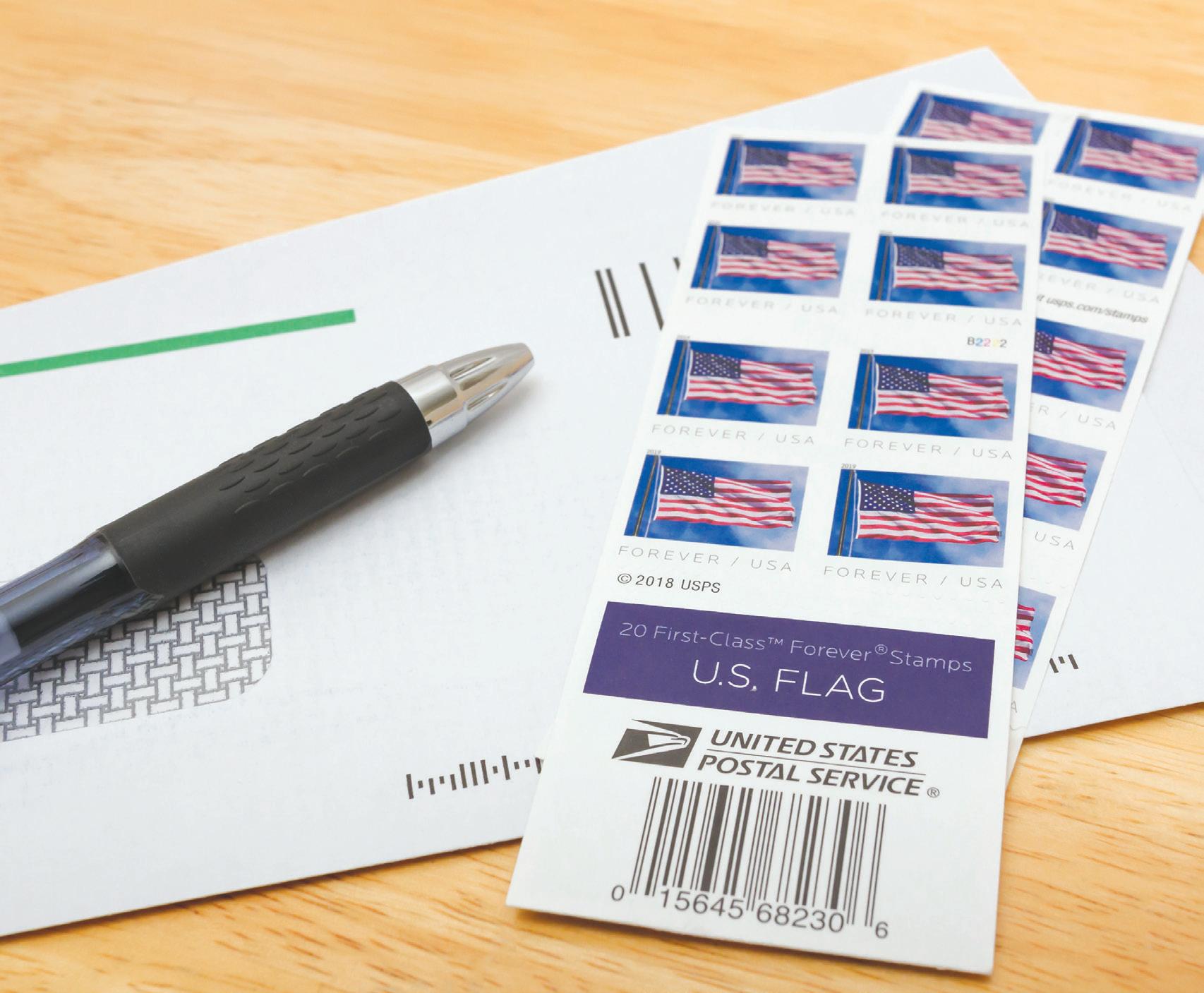
In the release of a new series of stamps in 2022, the U.S. Postal Service called the flag a symbol of endurance and hope. These stamps featured rural scenes in which U.S. flags were painted on barns.

We honor what we stand for as a nation - freedom, equality, justice & hope.
Lori DeVries Owner/Broker Associate







As time goes on and our country gets older, the meaning behind the flag can become less important to kids.

It’s important teachers and parents today pass down the history and meaning behind our nation’s flag. Here are some tips on lessons to teach.
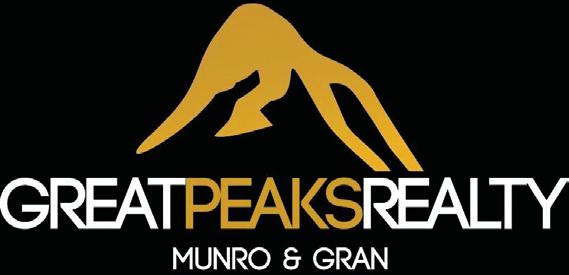
Teachers have the best chance to teach their students about the American flag and appropriate etiquette. It’s also important to encourage other teachers and even parents of your students to teach their

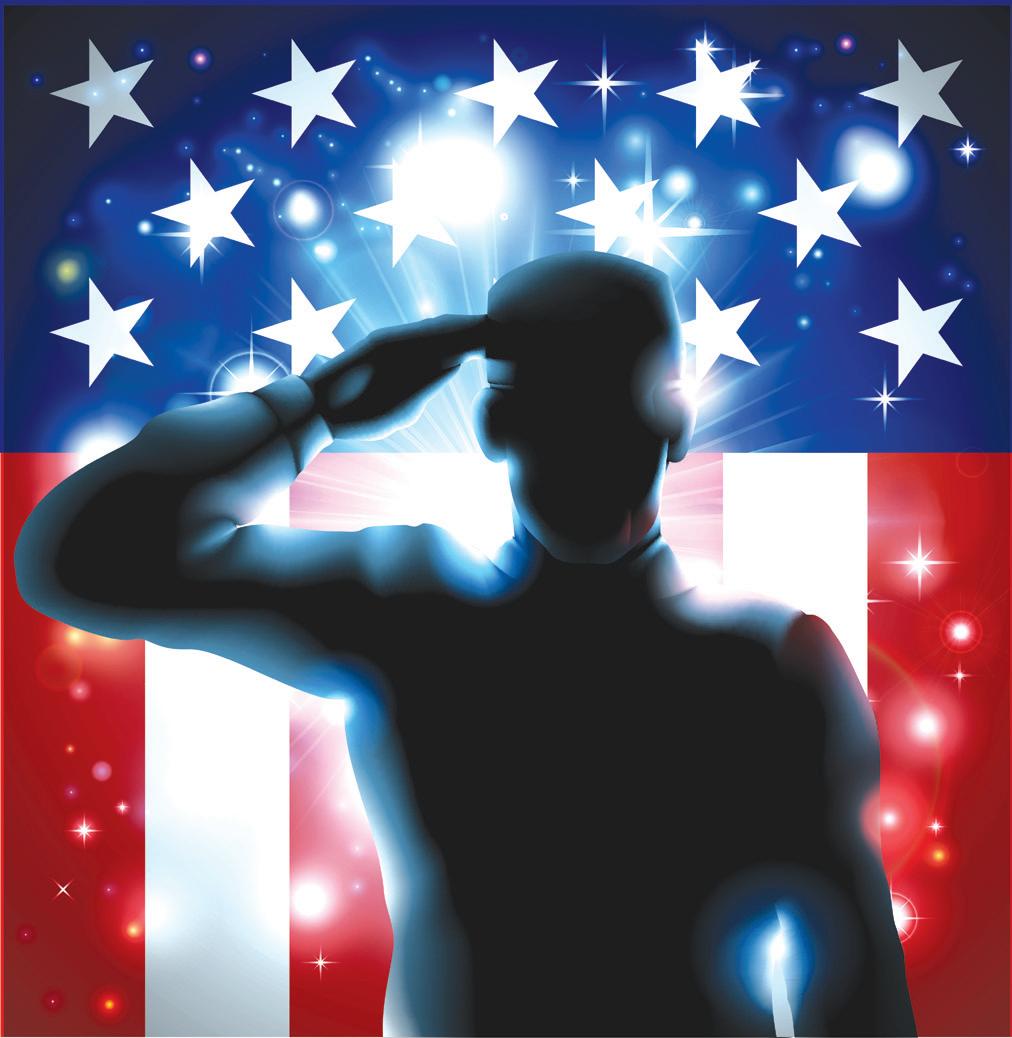
kids about the flag. Get together with principals and other teachers or parents in your school system who can create a special flag day event for all students. Invite leaders to speak to the student body of the importance of the flag and what it has meant to them in their lives.
Encourage students to participate in
some kind of group project together or individual projects to share what they have learned about the flag and what it has taught them.
Take the time as you are teaching
your students and kids about the flag to teach them about the rest of the United States history and how the flag ties into it all. They should learn how the U.S. began and how it evolved into the America we know today. Find online sources and software that can show a visual timeline of the states and how they changed.
A SALUTE TO OUR STARS & STRIPES AND TO THOSE WHO SERVED AND THOSE WHO CONTINUE TO SERVE.
In 1777, the Second Continental Congress adopted the colors and design of the U.S. flag.
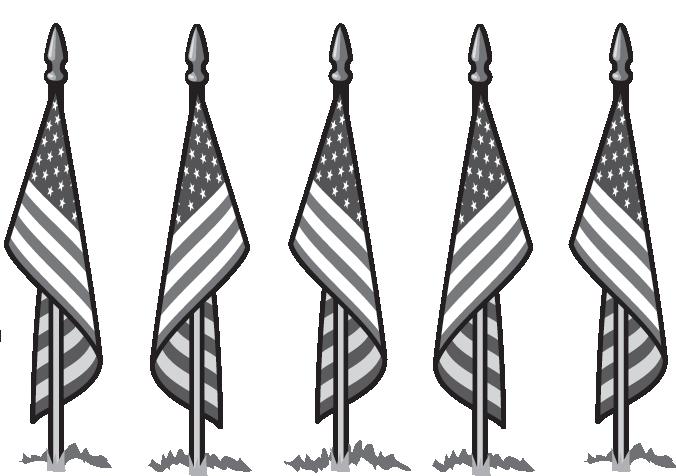
That same year, a 19-year-old French army officer arrived in the colonies who would help to change the course of U.S. history, a hero of two countries whose legacy would be tied up with the U.S. flag.
Gilbert du Motier, Marquis de Lafayette was a French aristocrat who first became a military officer at age 13. Because he believed in the American revolutionary cause, he traveled to America where he became a close confidant of Gen. George Washington and was appointed a major general.
He fought in major battles and then sailed to France to convince his homeland to commit more resources to the war effort. When he returned in 1780, he led troops in the Continental Army and was one of the heroes of the siege of Yorktown.
He and his family were granted citizenship in the U.S.
Upon returning home to France, he worked with Thomas Jefferson
to write his country’s “Declaration of the Rights of Man and of the Citizen” modeled on the U.S. Declaration of Independence. He was a major figure in the French Revolution, serving the king and promoting his ideas of a constitutional monarchy. At one point he was imprisoned in Austria and the U.S. unsuccessfully tried to use his American citizenship to free him. Jefferson, who was then Secretary of State, was able to get him funds as a “salary” for being a U.S. major general and Alexander Hamilton’s sister-in-law, Angelica Schuyler Church, tried to help him and his wife escape. While their plot was briefly successful, Lafayette was recaptured.
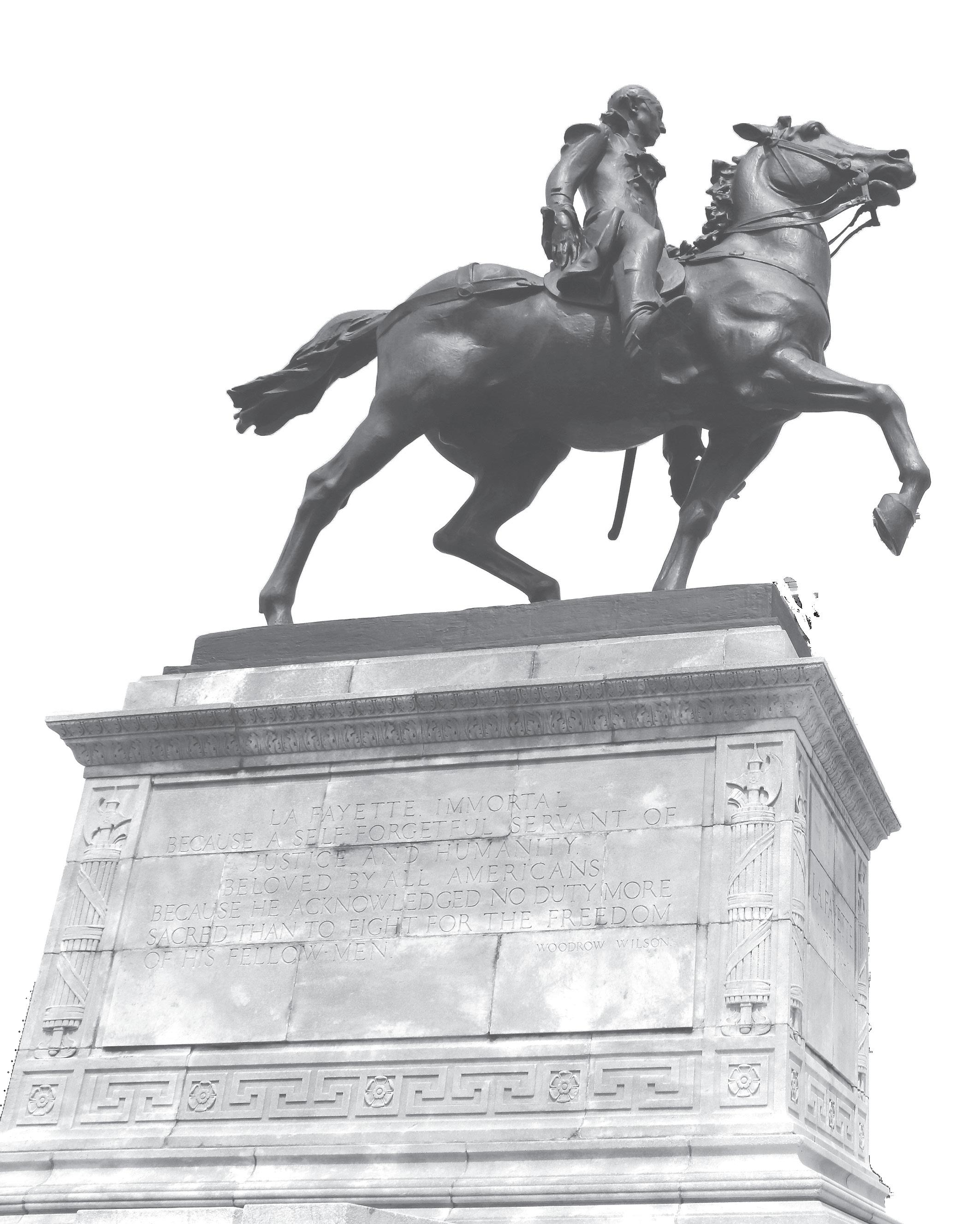
Eventually his wife and children were able to escape to the U.S.
After he was freed and returned to France, he was invited to make a triumphant return to the U.S. In 1824, President James Monroe sponsored his 13-month visit. He became the first foreign-born citizen to address a joint session of Congress. He visited each of the 24 states that were then a part of the Union, collecting soil from each state with the hope of being buried with it. However, the steamship he was traveling in sank in the Ohio River and all the soil was lost. He
Our Brave Veterans Past & Present
On Memorial Day and always, we remember and honor all who put service above self as members of our nation’s military. Thank you for your sacrifice and dedication to preserving our freedom.
instead gathered soil from Bunker Hill.
It would be his last time visiting the U.S.
When he died in 1834 in Paris, the Bunker Hill soil was sprinkled over his coffin. In the U.S., President Andrew Jackson ordered that Lafayette receive the same memorial honors that Washington was
on July 4 to replant the American flag, with Stanton famously declaring, “Lafayette, we are here.”
Even during the Nazi occupation of Paris from 1940-1944, the flag flew undisturbed.
Now, following the tradition of Pershing and Stanton, there is an annual ceremony on July 4 in which the flag is changed that is attended by French and American dignitaries.
5:30 PM • Wednesday, June 14 • Spearfish VFW Post 5860 3102 E. Fairgrounds Loop
VFW Post 5860 invites you to join us as the Boy and Girl Scouts in all program levels and the Spearfish Honor Guard pay our respects to our country’s flag with a flag retirement ceremony.
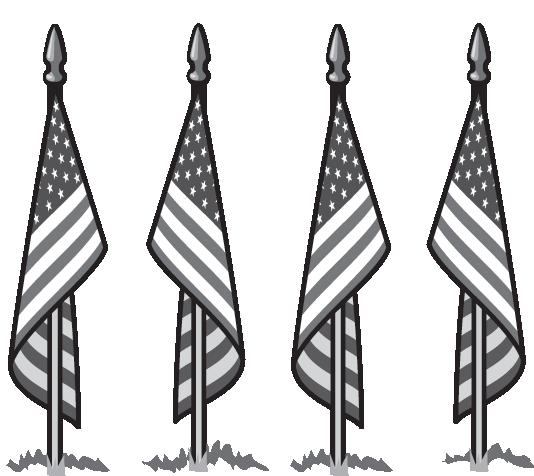
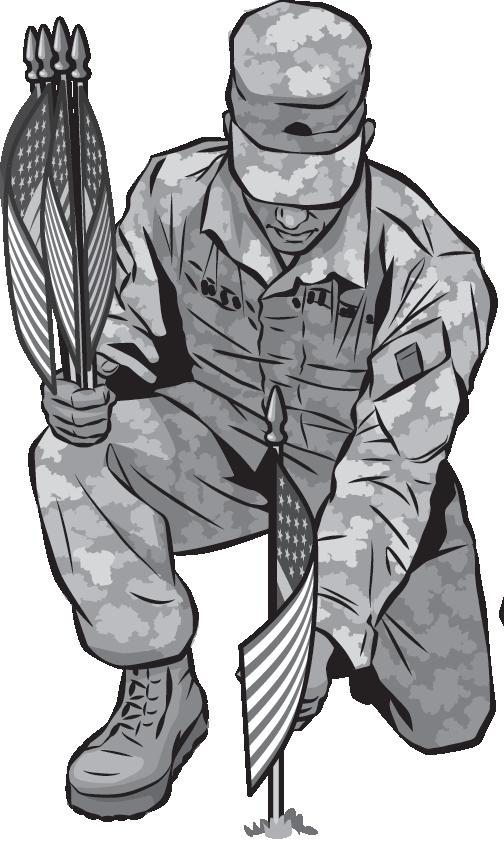
The Ceremony will begin at 5:30 pm with a meal of hotdogs and chips.
Following the meal, at dusk the flag will be lowered from the post flag pole and retired with all due respect.
Flags are a powerful symbol that inspire powerful emotions. Throughout our country’s history, people have expressed strong sentiments about the flag, both good and ill. Here are a few.
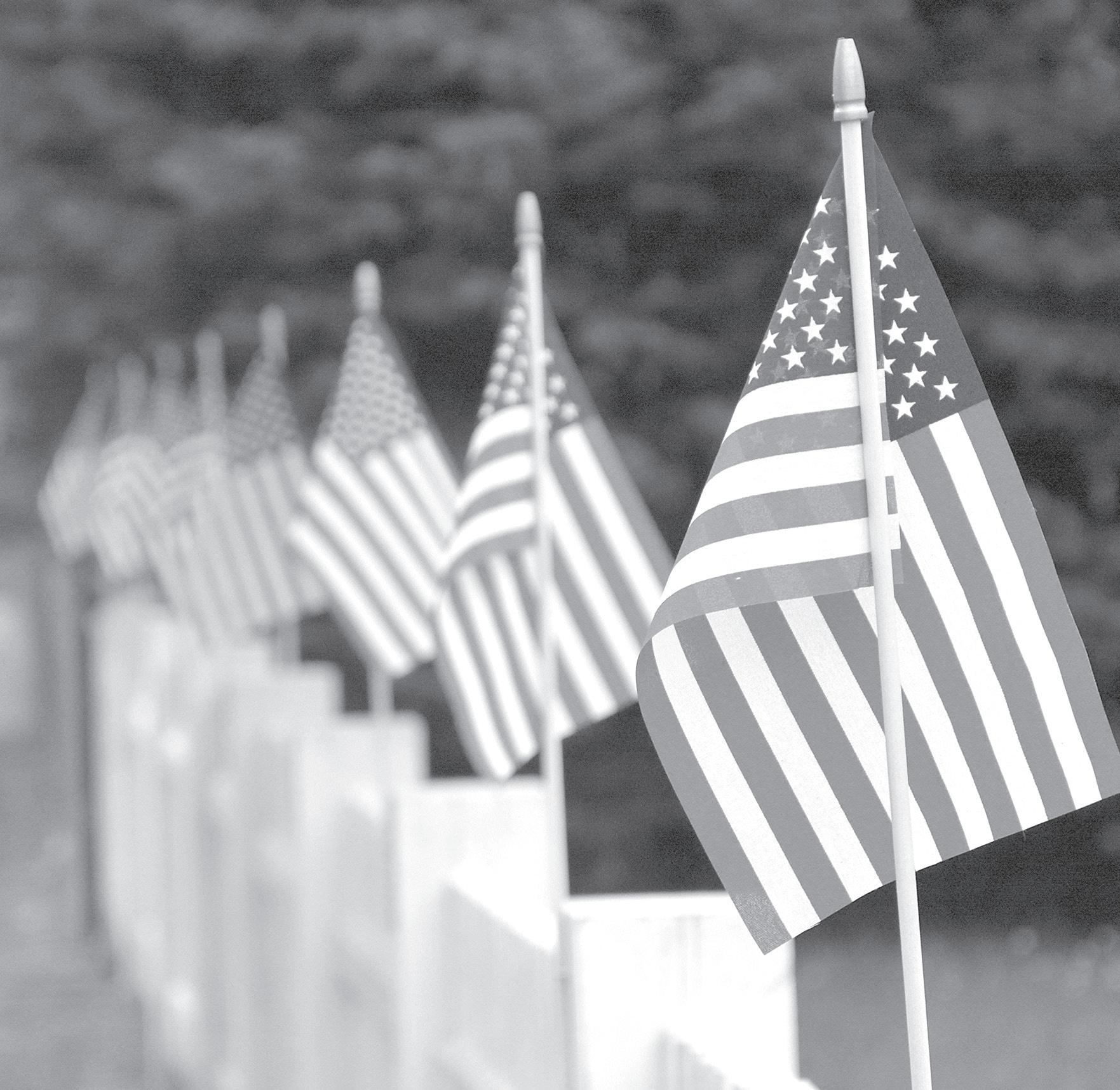
“I see Americans of every party, every background, every faith who believe that we are stronger together: black, white, Latino, Asian, Native American, young, old, gay, straight, men, women, folks with disabilities, all pledging allegiance under the same proud flag to this big, bold country that we love. That’s what I see. That’s the America I know!”
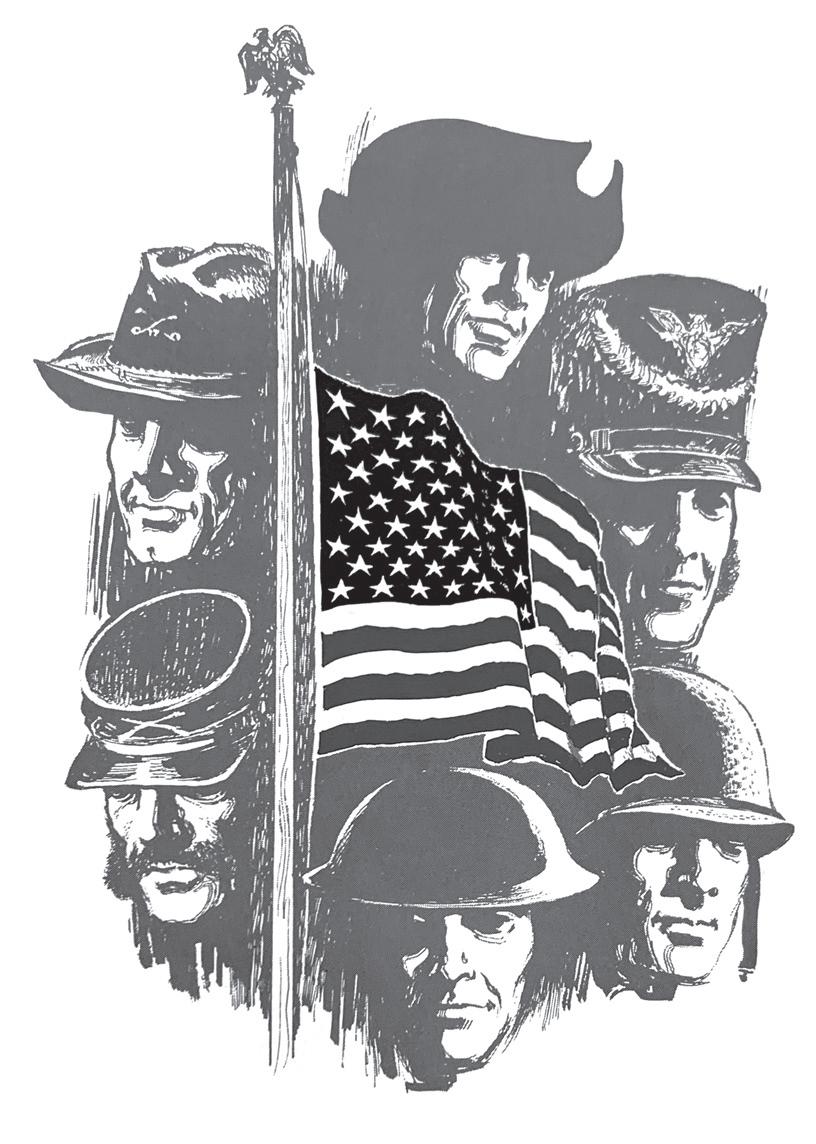
— Barack Obama, former president of the United States
“Standing as I do, with my hand upon this staff, and under the folds of the American flag, I ask you to stand by me so long as I stand by it.”
— Abraham Lincoln, U.S. president and signer of the Emancipation Proclamation
“We take the stars from heaven, the red from our mother country, separating it by white stripes, thus showing that we have separated from her, and the white stripes shall go down to
posterity, representing our liberty.”
— George Washington, the first president of the U.S.
“We identify the flag with almost everything we hold dear on earth, peace, security, liberty, our family, our friends, our home… but when we look at our flag and behold it emblazoned with all our rights we must remember that it is equally a symbol of our duties. Every glory that we associate with it is the result of duty done.”
— Calvin Coolidge, U.S. president POLITICIANS
“I believe our flag is more than just cloth and ink. It is a universally recognized symbol that stands for liberty and freedom. It is the history of our nation, and it’s marked by the blood of those who died defending it.”
— John Thune, GOP senator from South Dakota

“As long as I live, I will never forget that day 21 years ago when I raised
my hand and took the oath of citizenship. Do you know how proud I was? I was so proud that I walked around with an American flag around my shoulders all day long.”
— Arnold Schwarznegger, actor and former Calilfornia governor
“I prefer a man who will burn the flag and wrap himself in the Constitution to a man who will burn the Constitution and wrap himself in the flag.
— Craig Washington, Democratic lawmaker from Texas

“Martin Luther King, Jr. didn’t car -
ry just a piece of cloth to symbolize his belief in racial equality; he carried the American flag.”

— Adrian Cronauer, military broadcaster during the Vietnam War whose story was the basis of the movie “Good Morning, Vietnam”
“I’m proud of the U.S.A. We’ve done some amazing things. To wear our flag in the Olympics is an honor.”
— Shaun White, three-time Olympic gold medalist in snowboarding
“The red, white and starry blue — is freedom’s shield and hope.”
— John Philip Sousa, American composer and director of the U.S. Marine Corps band
heroes
In classrooms across the country, millions of students partake in saying the Pledge of Allegiance.
Unfortunately, many have merely memorized the words without understanding the significance it has to their country and freedom. If you are a parent or mentor, it’s important to educate our youth about its significance.



The Pledge of Allegiance gained its first major publicity through an official program called the National Public Schools Celebration of Columbus Day. It was September 8, 1892 when the prose was printed in the Youth’s Companion leaflet and distributed to schools throughout the country.
While it has seen a few revisions since its original form was penned by Francis Bellamy, it became a staple in classrooms while remaining unrecognized by Congress. According to the American Legion, it wasn’t until 1942, when the Pledge was officially included in the United States Flag Code and 1945 when the official name of the Pledge of Allegiance was adopted.
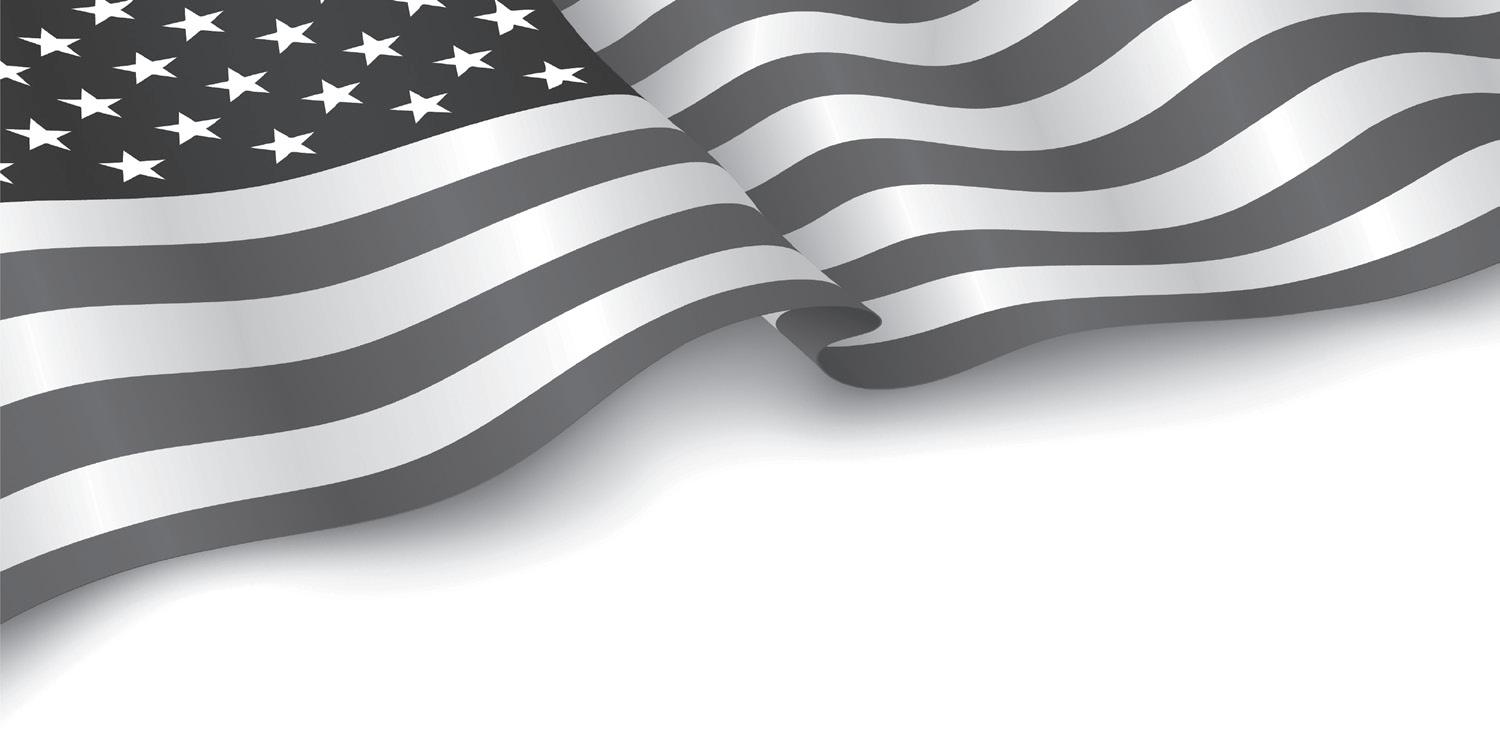

When discussing the Pledge of Allegiance with younger children, explain

that it is an opportunity to display their loyalty as a citizen to our country. It should be considered an act of unity for students to stand together and pay their respect to America’s banner.
Children should be encouraged to learn more about the meaning of the Pledge, rather than only recite the words. It is intended to inspire curiosity about the country’s history and help build a stronger sense of patriotism.

Much like the National Anthem, there is a proper way to show your respect to the flag during the Pledge. Here are the steps, from the U.S. Flag Code.
• The pledge is to be recited by standing at attention;

• Face the flag and place the right hand over the heart;


• People in uniform must face the flag, remain silent and take the military salute; and
• Those not in uniform must remove any non-religious headdress with their right hand, place it on their left shoulder, in such a way that their right hand is over the heart.

“I pledge allegiance to the Flag of the United States of America, and to the Republic for which it stands, one Nation under God, indivisible, with liberty and justice for all.”

As a part of showing the United States flag the utmost respect, the flag should be folded a certain way and stored or kept safely.
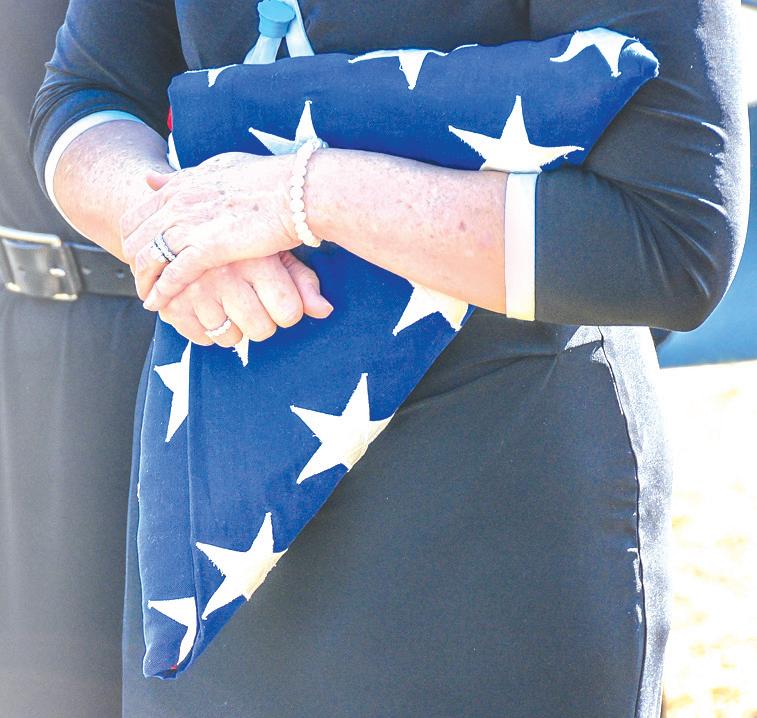
The American Legion demonstrates how to appropriately fold the flag.
First, you begin by straightening the flag to full length and folding lengthwise once.
Fold it lengthwise a second time to meet the open edge, making sure the union of stars portion remains outward in full view. A triangular fold is then started bringing the striped corner of the folded edge to the open edge.
After you’ve folded the first triangle, the outer point is then turned inward, parallel with the open edge, to form a second triangle. Continue the triangular folding through the blue union portion of the flag until the end is reached with only the blue showing.
If you didn’t know, the way the flag is folded carries a meaning. Legion.org shares the meaning behind the traditional way the United States Flag is folded.
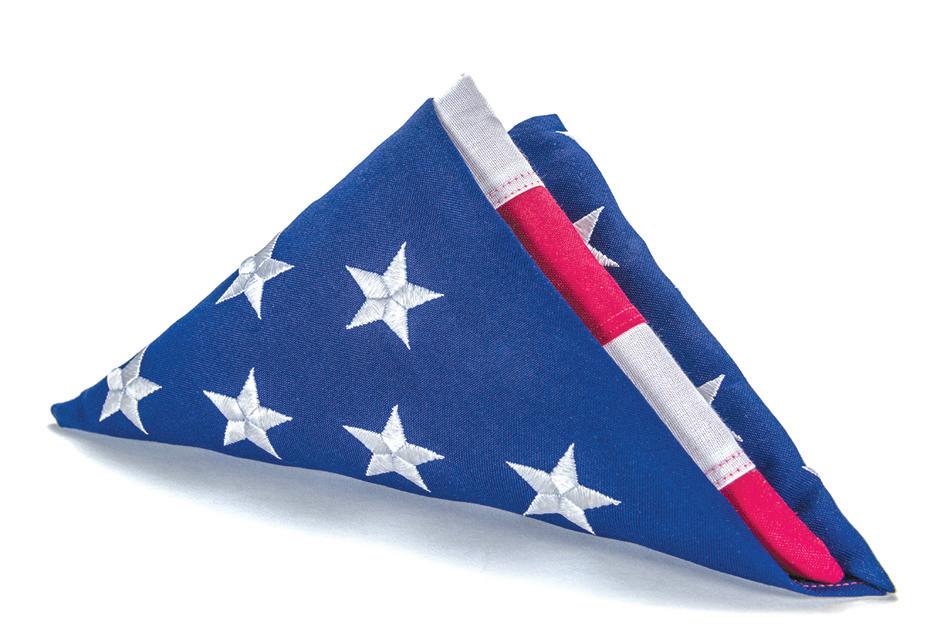
AmericanLegion.org says the flag-folding ceremony represents
the same religious principles on which our country was originally founded. In the U.S Armed Forces, during the ceremony of retreat, the flag is lowered, folded and kept under watch throughout the night as a tribute to our nation’s honored dead. The following morning the flag is brought out and represents the symbol of the nation’s belief in the resurrection the body.
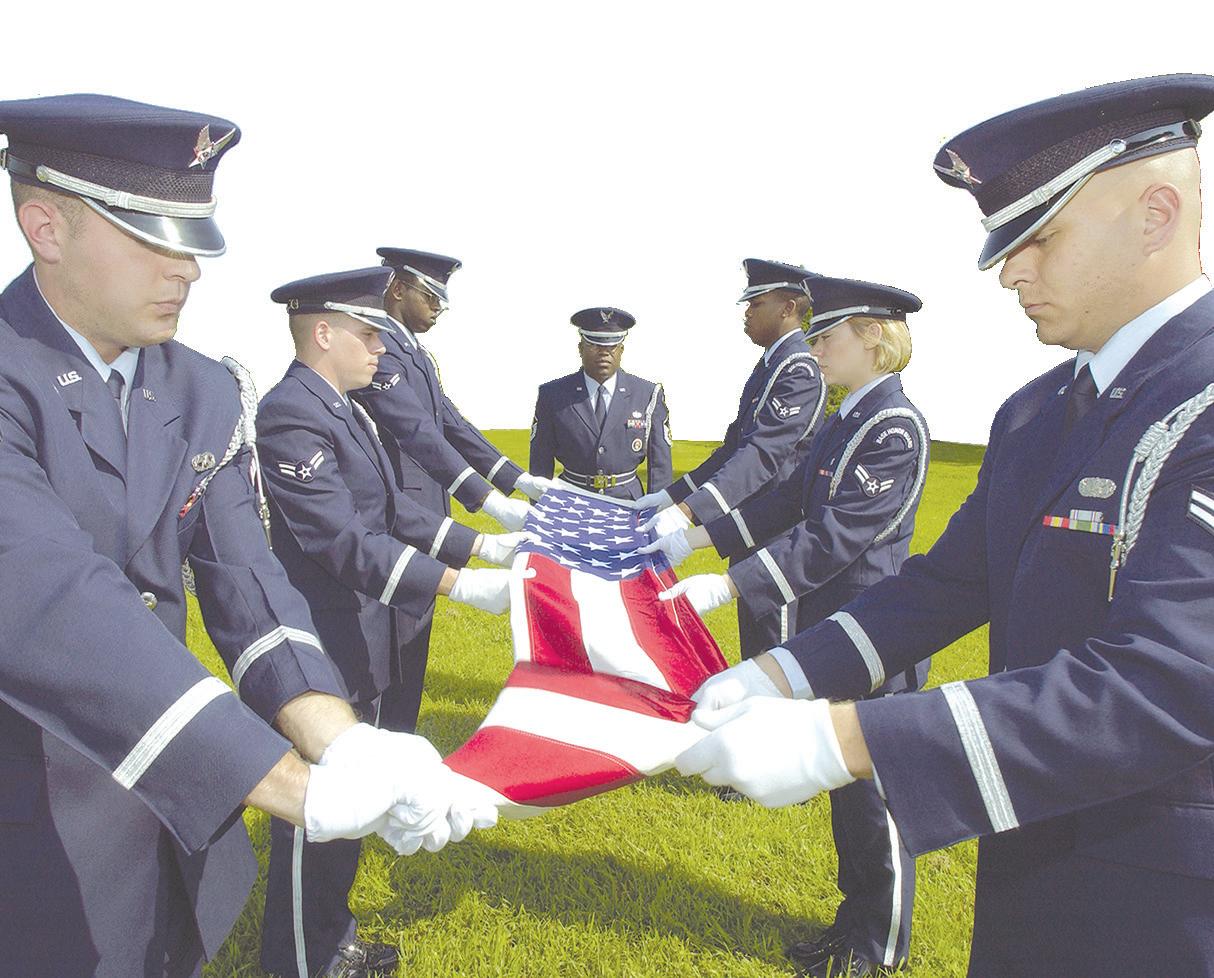

The flag is not just a cloth that represents our country and all it’s glory. The flag has meaning behind its colors and its design. The flag-folding process, if done correctly, should only be folded about 12 times.
The proper way to destroy a worn out non-serviceable flag is by burning. Although the flag code suggests individuals should do so discretely so it is not perceived as a protest or desecration.
We dedicate our thanks to those who dedicated their lives to this great country. Their courage, service and sacrifice will never be forgotten.
We salute the military heroes we have lost, and those who continue to protect our freedom today.